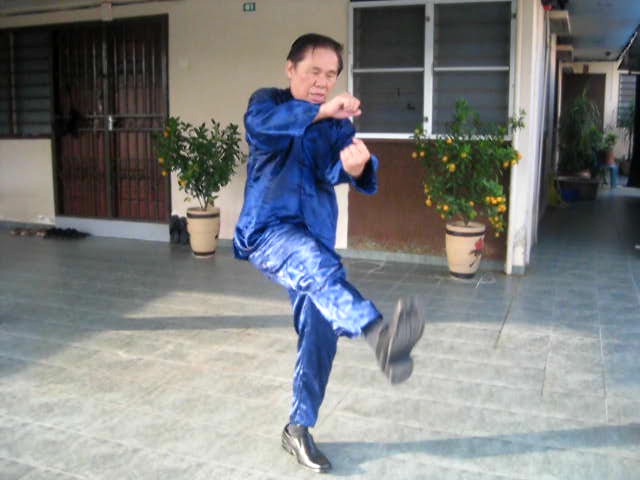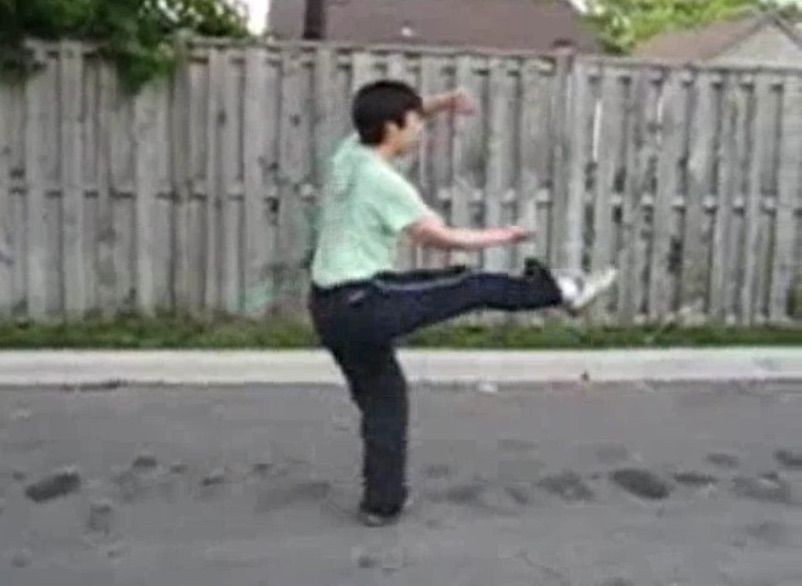EIGHTEEN LOHAN FIST AND SHAOLIN TANTUI

Eighteen Lohan Fist
Question
Could you please elaborate on the relation between the 18 Lohan Fist and Tan Tui?
What are the similarities and differences between these in terms of philosophy, form, force training, tactics and strategies?
Steffen
Answer
Tantui was a logical development of the Eighteen-Lohan Fist. The Eighteen-Lohan Fist developed from the Eighteen Lohan Hands over a period of time, and became the prototype of Shaolin Kungfu, often called Shaolin Lohan Kungfu.
Interestingly, “Shaolin Lohan Kungfu” was called “shao lin luo han quan” in Chinese. As the Eighteen-Lohan Fist was practiced at the Shaolin Temple, it was called “Shaolin Lohan Fist”, which was also “shao lin luo han quan” in Chinese.
There were a few terms in Chinese meaning martial art or kungfu, one of which was “quan”, which literally meant “fist”. Other popular terms were “wuyi” and “wushu”, which meant “martial art” and “martial techniques” respectively.
To denote that it was a martial art, the terms “fa” and “shu”, which meant “technique” and “skill”, were often suffixed to “quan”. Hence Shaolin Kungfu could be called “Shaolin Quanfa”, Shaolin Quanshu”, Shaolin Wuyi” or “Shaolin Wushu”.
It is significant to note that in modern Western societies, the word “wushu” has now taken the concept of “kungfu forms for demonstration”. But in Chinese, the word “wushu” means “martial art”, although wushu practitioners today do not practice the art for combat. Hence, we sometimes have the debate whether wushu can be used for fighting.
The Chinese generally do not have difficulty debating whether Shaolin Kungfu should be called Shaolinquan or Shaolin Wushu, because they usually use words for convenience, and not as rigid definition. As far as I know there is no record of how the term evolved, but I believe that gradually and without their conscious awareness monks with martial art background called what they practiced “luo han quan”, or Lohan Fist, instead of “luo han shou”, or Lohan Hands, as they changed their open hands into close fists for martial purposes.
This evolution continued over time, a little at a time without significant difference at the moment, but over a long period the resultant practice was quite different from when it initially started. That, I believe, was how the Lohan Fist or Lohan Kungfu developed. It also explained why there are now many different versions of the Lohan Fist set. The Lohan Fist practiced during the Song Dynasty, for example, would be very different from the Lohan Fist practiced in the preceding Tang Dynasty. Shaolin Kungfu has a very long history.
As Lohan Fist was practiced at the Shaolin Temple, it was also called Shaolin Fist, or Shaolin Kungfu. It remained as the main style of kungfu practiced in the Shaolin Temple. Shaolin Kungfu also spread far and wide outside the temple, and developed special characteristics by different masters and in different regions, like Xingyiquan, Wuzuquan and White Crane.
These styles that evolved from Shaolin Kungfu, which was mainly Lohan Fist, initially were prefixed by the term “Shaolin”, like Shaolin Xingyiquan, Shaolin Wuzuquan and Shaolin White Crane. To differentiate from these styles, the kungfu practiced in the Shaolin Temple was called Shaolin Lohan Kungfu, but sometimes simply called Shaolin Kungfu or Lohan Kungfu.
We must remember that these terms were used for convenience, and they do not refer to just one definitive style of kungfu and no others, unlike in scientific definition where “carbon dioxide” refers just to carbon dioxide, and not to anything else. The Shaolin Kungfu or Lohan Kungfu practiced in the Shaolin Temple in the Ming Dynasty, for example, could be very different from the Shaolin Kungfu or Lohan Kungfu practice in the same temple in the preceding Song Dynasty.
In the Ming Dynasty Shaolin Kungfu, which was Lohan Kungfu, spread to and practiced in the Long Tan Si, or Dragon Pond Temple, in Shandong in north-east China. Here practitioners specialized in snap kicks, or spring kicks, i.e. the kick snapped or sprung out from their bent knees. In Chinese such kicks were called “tan tui”.
Eventually the style of Shaolin Kungfu originated from the Long Tan Temple where a prominent aspect was a spring-kick, was called Shaolin Tantui. It is not conclusive whether the term “Tantui” came from the Long Tan Temple or from the spring-kick which in Chinese is called “tantui”. Personally I think both could be true. The Chinese were, and still are, pragmatic rather than intellectual. They were more interested in the practical benefits of Tantui, like how its practice contributed to combat efficiency as well as good health, vitality and longevity, than in arguing the exact source if the term.
In Mandarin, “pond” in Dragon Pond Temple, and “spring” in “spring-kick”, are both pronounced as “tan”, though the written words are different. But in Cantonese, “pond” is pronounced as “tham”, and “spring” as “than”.
When I first learned the 12 sequences of Tantui, I called it “tham thui”, which in written characters means “pond-kick”. Later when I researched into the art, I found that it was popularly practiced by the Muslim population in north-west China and was called “than thui” in Cantonese or “tantui” in Mandarin which means “spring-kick”, with 10 sequences.
Interestingly, Tantui is just called “Tantui”, without the suffix “quan’ added to it. Unlike Lohan Kungfu which is called “Luohanquan” in Chinese, or Taiji Kungfu which is called “Taijiquan”, Tantui has never been called “Tantuiquan”. Infrequently, it may be called “Tantui Wushu”, which means the martial art of spring-kicks, or the martial art that originated from the Dragon Pond Temple.
The similarities between Lohan Fist and Tantui are quite obvious for the initiated. There are, of course, also differences.
The philosophy of Lohan Fist and Tantui is the same. For convenience, we may divide their philosophy into three levels, for combat, for health, and for spiritual cultivation.
Both Lohan Fist and Tantui are very effective for combat – for those who know and have the necessary skills. In fact, combat efficiency was the first reason why Lohan Fist and Tantui were created and practiced.
However, today most Lohan Fist and Tantui practitioners do not know how to apply their art for combat. Many people explicitly practice Tantui for health. Some Chinese schools teach Tantui, without its martial aspect, during lesson periods for physical education.
It is very rare nowadays that people practice Lohan Fist or Tantui for spiritual cultivation, although their training, without the awareness of the practitioners, actually nourishes the spirit. We in Shaolin Wahnam are different. Every practice is a training of the physical, energy and mind or spirit. Indeed, we start and complete every training session with spiritual cultivation in smiling from the heart and standing meditation.
The philosophical difference is that, due to ignorance and convention rather than genuine reasons, Lohan Fist is generally considered to be advanced, whereas Tantui is considered elementary. When a student says that he is learning Lohan Fist, those who knows something about kungfu may think he is advanced. When a student says he is learning Tantui, they may think he is a beginner.
This is probably due to convention. Lohan Fist is normally taught at advanced levels, whereas Tantui at the beginning. Historically, it is the reverse. Tantui, being a development from Lohan Fist, has more sophisticated techniques.
The form is similar. Both use long stances and extended arms, except in Southern Lohan Fist, which was a later development from Northern Lohan Fist, and generally later than Tantui. While the stances and arm movements of Southern Lohan Fist are longer than those in Wing Choon and Monkey Style, they are shorter than those in Northern Lohan Fist and Tantui.
Both Lohan Fist and Tantui use the fist and open palm. Sophisticated hand forms like dragon hand-from, leopard punch and phoenix-eye fist are not present.
The difference between Tantui and Lohan Fist, however, is that Tantui kicks, as expected of an art that specializes on the leg, are more sophisticated. Toe-kick, sweeping kick and hook-spring are found in Tantui, but not in Lohan Fist.
Unlike in Southern Shaolin styles like Hoong Ka and Wing Choon where force training is incorporated into the sets, though some practitioners may not realize it, kungfu sets in Lohan Fist and Tantui deal mainly with techniques. Practitioners have to practice force training methods outside their sets.
In other words, by only practicing their kungfu sets, like Triple Stretch and Siu Lin Tou, Hoong Ka and Wing Choon practitioners can develop internal force, but not practitioners of Lohan Fist and Tantui. They have to practice force training methods separately. The Eighteen-Lohan Art was a common choice in the past, but is now seldom known to many practitioners. Again, we in Shaolin Wahnam are different. Because of our spread and depth, every of our practice is a training of the physical, energy and mind.
The tactics and strategies of Lohan Fist and Tantui are similar. Both employ the principle of “using hard to overwhelm soft”, pressing into opponents with sheer force and speed.
Both use strategies like “If there is form, strike the form.; if there is no form, chase the shadow” and “tiger entering a herd of sheep”. Strategies like “tempt an opponent to advance to futility” or “sound east strike west” are seldom used.
Although Lohan Fist and Tantui use similar tactics and strategies, the difference is that Lohan Fist is more frontal, whereas Tantui is more swing-like. Lohan Fist attacks are like cannon balls shooting at opponents, whereas Tantui attacks are like iron rods striking helpless sheep. The description is relative and in general. There are also frontal attacks in Tantui, and swing-like attacks in Lohan Fist.
A philosophical understanding of the relationship between Lohan Fist and Tantui, as well as their similarities and differences not only enable us to benefit more in our training, not only in Lohan Fist and Tantui but also in other kungfu styles, but more significantly enrich our daily life.
Knowing the development of Tantui from Lohan Fist, we can also know in principle though not in specific situations, the development of other styles like Taijiquan and Wing Choon Kungfu. Knowing the similarities and differences between Lohan Fist and Tantui will also enable us to appreciate the similarities and differences between Wuzuquan and Eagle Claw, or any kungfu styles.
More significantly, we can better understand and improve our daily life. We may, for example, see how a manager developed from being a clerk, or how your girlfriend may become your wife. We can also better appreciate the similarities and differences between a manager and a clerk, between a girlfriend and a wife, or between any events or relationship in daily life.

Shaolin Tantui
Little Lohan Fist
18-Lohan Fist
Treasure House of Kungfu Sets
Treasure House of Combat Application
Those who wish to attend the 18-Lohan Fist course in Frankfurt, Germany on 26th, 29th, 30th September and 1st October 2014, please contact Secretary, Wahnam Germany or phone (069) 904-31954.
The questions and answers are reproduced from the thread 10 Questions on 18-Lohan Fist in the Shaolin Wahnam Discussion Forum.
LINKS
